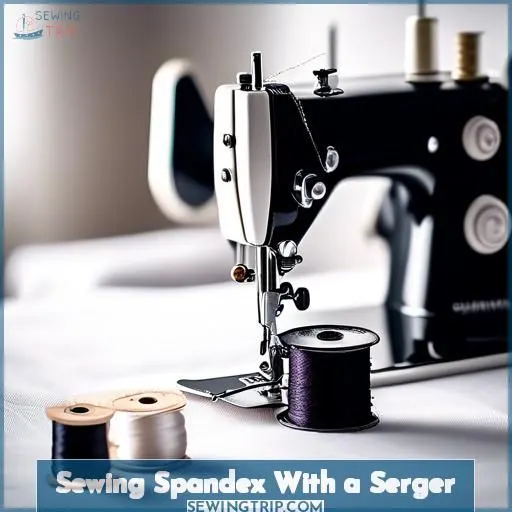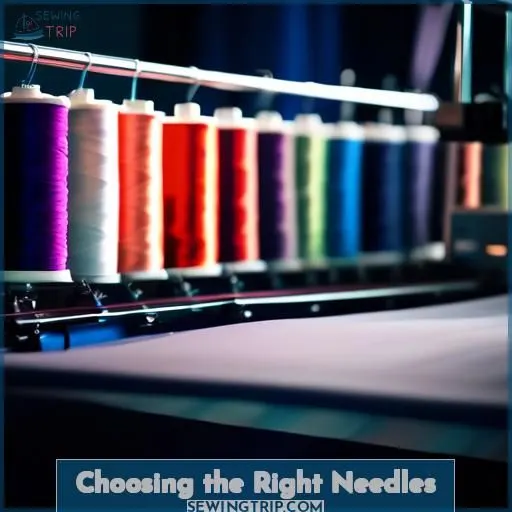This site is supported by our readers. We may earn a commission, at no cost to you, if you purchase through links.
 Mastering spandex with a serger requires precision and attention to detail.
Mastering spandex with a serger requires precision and attention to detail.
You’ll learn to select the ideal needles and threads.
Adjust serger settings for optimal results.
Prepare the fabric meticulously.
Discover techniques to test and fine-tune your stitching.
Ensure professional-quality finishes on stretchy fabrics.
Unlock your sewing potential by expertly handling spandex.
Elevate your projects to new levels of excellence.
Table Of Contents
Key Takeaways
- Adjust serger settings, such as tension and differential feed, to accommodate spandex’s elasticity.
- Choose appropriate needles, like ballpoint or stretch needles, and thread, like polyester thread, for sewing spandex.
- Prepare the spandex fabric by washing, drying, and cutting it accurately to ensure a neat finish.
- Test and adjust stitching on scrap fabric to find the optimal stitch length and width for your specific fabric.
How to Sew Spandex With a Serger?
To sew spandex with a serger, it’s essential to use a neutral differential feed and a medium stitch length, while ensuring the fabric is stretched properly as it’s fed through the machine. This technique helps create durable seams that can stretch with the spandex fabric.
Sewing Spandex With a Serger
Sewing spandex with a serger can be a bit tricky, but with the right settings and techniques, you can achieve professional results.
- Serger Tension: Adjust the tension to ensure a balanced stitch. The tension settings can vary depending on the spandex content of the fabric and the finish on the fabric (foil, matte, shiny, etc.). For a standard 80% nylon/20% spandex, the settings might be lower looper 5, upper looper 4, right needle 4, and left needle 3.5.
- Differential Feed: Set the serger for the correct differential feed setting. Fiber content and the presence or percentage of spandex dictate the correct setting. For example, if you’re sewing a 50% nylon/50% spandex fabric, you might set the differential feed to 1.5.
- Rolled Hem: To create a rolled hem, use a wide stitch width and short stitch length on a zig zag stitch. Stretch the fabric firmly as you zig zag over the edge, maintaining stretch. Let a slight edge of the fabric curl over when sewing for a nicer finish.
- Blind Hem: For a blind hem, set the serger for a 4-thread stitch. Stretch the fabric as you serge, holding it taut to prevent bunching.
- Coverstitch: To sew a coverstitch, use a 3 or 4 thread serger setup with a narrow cutting width and short stitch length. Hold the fabric taut from both ends and stretch just enough to flatten it.
Remember to test your stitching on scrap fabric with the same thread and needle before starting your project. This will help you find the optimal stitch length and width for your specific fabric.
Choosing the Right Needles
When sewing spandex with a serger, it’s crucial to choose the right needles. Select needles designed for stretch fabrics, such as ballpoint or stretch needles, to prevent fabric damage and ensure smooth stitching.
Choose appropriate needles
When sewing spandex with a serger, choosing the right needles is crucial.
Opt for spandex needles with a stretch stitch, which allows the fabric to stretch without damaging the thread.
Needle size and type can vary depending on the fabric’s thickness.
Always check the packaging for the appropriate needle.
The needle point should be sharp and designed for stretch fabric.
By selecting the right needle, you’ll ensure a smooth sewing process and a durable finished product.
Select suitable thread
When it comes to sewing spandex, choosing the right thread is just as crucial as selecting the proper needle. Spandex thread, often made from polyester, is a must-have for sewing spandex fabrics. It’s designed to provide some stretch and durability, ensuring your seams remain intact even with the fabric’s natural elasticity.
When it comes to thread weight, it’s essential to match the thread’s weight to the fabric’s weight. Lighter fabrics require lighter thread, while heavier fabrics require heavier thread. The thread’s color should also be considered, as it should either match the fabric color or blend well when using multiple colors.
For sewing machines, it’s recommended to use a zigzag stitch or a narrow zigzag stitch on regular sewing machines, while sergers are recommended for increased stretch and durability. When using a serger, set the differential feed to neutral and use a medium stitch length. For structural seams, a 4-thread flat serger stitch is preferred, while a 3-thread overlock can be used for finishing seams.
When hemming spandex, it’s essential to stretch the fabric throughout the seam to ensure a proper fit. Different hem styles, such as cut hems, flat hems, lettuce edge hems, and specialized hems like fishing line hems, horsehair braid hems, and appliqued hems, require specific thread types and sewing techniques.
In summary, when sewing spandex, it’s essential to choose the right thread, which is often polyester thread, to ensure the fabric’s natural stretch and durability. The thread’s weight, color, and type should be considered, and different stitching techniques should be used depending on the hem style.
Adjust serger settings
Once you’ve got your thread and needle game on point, it’s time to tweak those serger settings for the perfect stretch.
- Adjust the needle and thread tension just right—like finding the sweet spot in a cozy hammock.
- Play around with the stitch length; think of it as the rhythm to your sewing song.
- Set the differential feed to avoid puckers or waves, making your fabric glide smoother than a hot knife through butter.
Selecting the Appropriate Thread
Select thread that matches your fabric’s color for a seamless finish. You’ll also want to adjust your serger settings for a stretch stitch to accommodate the fabric’s elasticity.
Choose appropriate thread
When it comes to sewing spandex, thread selection is crucial.
Choose polyester thread, such as Gutermann or Mettler, for its stretch and durability.
Match the thread color to the fabric color or mesh for a seamless look.
Use a thread color that blends well when using multiple colors.
Finish seams in meshed areas with thread that matches the mesh.
Camouflage obvious seams with a straight stitch in a more appropriate color.
Stay stitch on either side of the new seam.
Set serger for stretch
Setting your serger for stretch is like tuning a guitar for a rock concert; it’s all about harmony.
Crank up the differential feed.
Balance the needle tension.
Pick a stitch length that lets your spandex groove without snapping.
Keep the thread tension in check.
Too tight and you’ll strangle the stretch.
Too loose and the seam’s a no-show.
Choose a stitch type that makes your spandex sing.
Stretch fabric while sewing
To sew spandex effectively, you must stretch the fabric as you sew. Here’s how:
- Choose the right needle: Opt for a ballpoint or stretch needle with a sharp tip and a large eye for easy threading.
- Select suitable thread: Use polyester thread for its elasticity and strength, like Gutterman or Mettler.
- Adjust serger settings: Set the differential feed to neutral and use a medium stitch length for optimal stretch.
- Stretch the fabric: Keep the fabric taut from both ends while sewing, but don’t stretch it from the front to avoid waviness.
By following these steps, you’ll be able to sew spandex with ease and maintain its stretch, ensuring your seams are strong and durable.
Preparing the Fabric
Preparing the fabric for sewing spandex with a serger is a crucial step in ensuring a successful sewing experience.
First, you need to cut the spandex fabric using sharp scissors or a rotary cutter.
It’s essential to be precise in your cutting to avoid wastage and ensure the best fit.
Before sewing, wash the spandex fabric in cold water with a mild detergent.
Avoid bleach or fabric softeners, as they can damage the fabric.
After washing, lay the fabric flat to dry, pressing it lightly with a cool iron if needed.
Once the fabric is dry, cut out the pattern pieces using pattern paper or tracing paper.
Measuring tape, iron, and ironing board are also essential tools for accurate fabric preparation.
By following these steps, you’ll be well-prepared to sew spandex with a serger, ensuring a neat and professional finish.
Testing and Adjusting Stitching
To master the art of sewing spandex with a serger, it’s crucial to test and adjust your stitching. Start by practicing with a scrap of spandex fabric using the same thread and needle you’ll use for your project. This will help you understand how the fabric reacts to the stitching process and identify any issues that may arise.
As you sew, stretch the fabric in all directions to ensure the stitches are evenly distributed and the fabric isn’t bunching or puckering. If you notice any tension issues, adjust your serger settings accordingly. This may involve tweaking the differential feed, stitch length, or stitch width.
Remember to use a zig-zag stitch, three-step zigzag stitch, or stretch stitch for maximum stretch. If you’re unsure about the settings, consult your serger’s user manual for guidance.
Once you’ve sewn a test seam, examine it closely. Look for any loose or tight stitches, uneven stitching, or fabric bunching. If necessary, use a seam ripper to remove the stitches and make adjustments.
To maintain the quality of your stitching, it’s essential to keep your serger in top condition. Regularly clean and maintain your machine, and replace worn or damaged parts as needed.
When you’re satisfied with your stitching, press the seam on an ironing board using a paper stabilizer to prevent any potential shrinkage or distortion. This step is crucial for achieving a professional-looking finish.
In conclusion, testing and adjusting your stitching is a meticulous process that requires patience and attention to detail. By following these steps and practicing regularly, you’ll be well on your way to mastering the art of sewing spandex with a serger.
Frequently Asked Questions (FAQs)
How do I choose the right needles for sewing spandex with a serger?
Use stretch or ballpoint needles to sew spandex on a serger – sizes 75/11 or 90/14 work best.
What type of thread should I use for sewing spandex with a serger?
Try polyester or polyester-wrapped poly thread – it stretches without breaking. Imagine elastic bands snapping if you use inelastic cotton.
How should I prepare the spandex fabric before sewing with a serger?
Prewash the spandex fabric before cutting to allow for shrinkage. Iron it flat without heavy steam. Lay the fabric out smoothly to cut pattern pieces using sharp scissors or a rotary cutter.
What stitch settings should I use for sewing spandex with a serger?
For sewing spandex on a serger, use a 4-thread overlock stitch with differential feed set to neutral. Opt for a medium stitch length, like 5-3mm, and stretch the fabric gently as you guide it through the machine.
How can I test and adjust the stitching when sewing spandex with a serger?
Testing your serger stitches? Sew scrap fabric sections, analyzing stretch and stitch formation. Adjust tensions, stitch lengths – that finicky dance between needle, looper, and Material Mistress Spandex until perfection reigns.
Conclusion
Mastering how to sew spandex with a serger unlocks new heights of professional sewing excellence. With the ideal needles, thread, fabric preparation, and meticulous testing, you’ll achieve impeccable stretchy fabric stitching.
Expertly handle this unique material, overcoming challenges through precise technique. Elevate every spandex project with superior finishes that showcase your skillful serger mastery.









